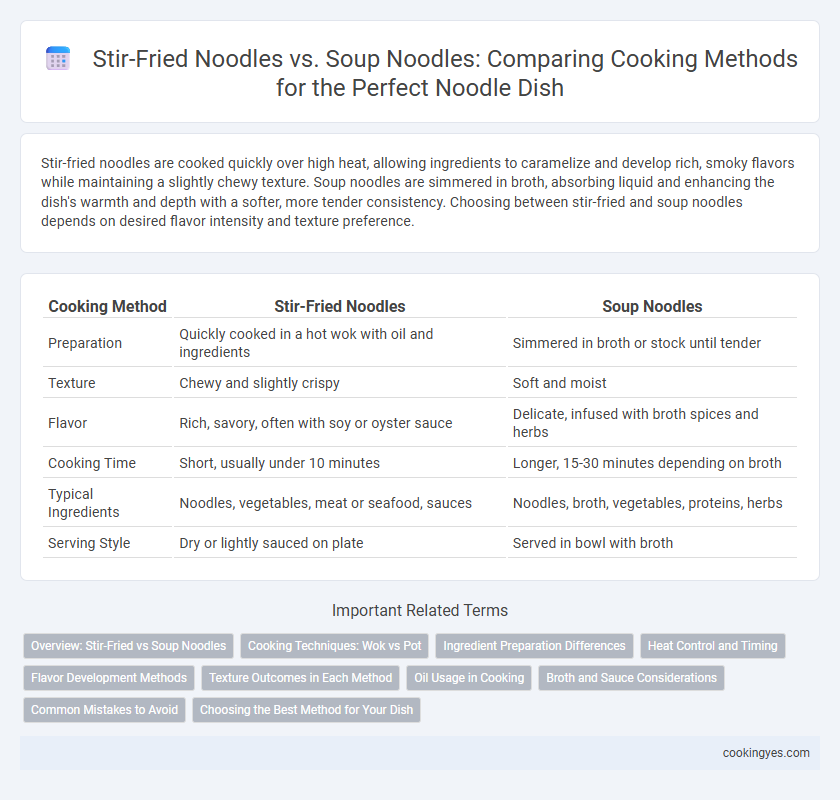Stir-fried noodles are cooked quickly over high heat, allowing ingredients to caramelize and develop rich, smoky flavors while maintaining a slightly chewy texture. Soup noodles are simmered in broth, absorbing liquid and enhancing the dish's warmth and depth with a softer, more tender consistency. Choosing between stir-fried and soup noodles depends on desired flavor intensity and texture preference.
Table of Comparison
| Cooking Method | Stir-Fried Noodles | Soup Noodles |
|---|---|---|
| Preparation | Quickly cooked in a hot wok with oil and ingredients | Simmered in broth or stock until tender |
| Texture | Chewy and slightly crispy | Soft and moist |
| Flavor | Rich, savory, often with soy or oyster sauce | Delicate, infused with broth spices and herbs |
| Cooking Time | Short, usually under 10 minutes | Longer, 15-30 minutes depending on broth |
| Typical Ingredients | Noodles, vegetables, meat or seafood, sauces | Noodles, broth, vegetables, proteins, herbs |
| Serving Style | Dry or lightly sauced on plate | Served in bowl with broth |
Overview: Stir-Fried vs Soup Noodles
Stir-fried noodles are cooked using high heat and a quick frying technique that results in a slightly crispy texture with a flavorful coating of sauce, often incorporating vegetables and proteins. Soup noodles, in contrast, are simmered or boiled in broth, offering a moist and tender bite infused with rich, savory flavors, and are usually served with a variety of garnishes like herbs and spices. The choice between stir-fried and soup noodles largely depends on the desired texture and flavor profile, with stir-fried noodles delivering a more robust, concentrated taste and soup noodles providing a comforting and aromatic experience.
Cooking Techniques: Wok vs Pot
Stir-fried noodles are typically cooked in a wok over high heat, using rapid tossing and searing techniques to achieve a slightly charred, smoky flavor and a chewy texture. Soup noodles require boiling in a pot, where immersion in hot broth allows the noodles to absorb liquid and become tender while maintaining a smooth, slippery consistency. The wok method emphasizes dry heat and constant motion, while pot cooking focuses on gentle simmering or boiling for even cooking and flavor infusion.
Ingredient Preparation Differences
Stir-fried noodles require ingredients to be sliced thinly and precooked or partially cooked to ensure even cooking during high-heat frying, often including proteins, vegetables, and sauces prepared separately. In contrast, soup noodles involve preparing broth ingredients such as aromatics, bones, or spices for simmering, with noodles cooked directly in the broth or added last to preserve texture. The key difference lies in ingredient timing and preparation: stir-frying emphasizes quick, high-temperature cooking with prepped components, while soup noodles focus on slow, flavor-infusing broth preparation and delicate noodle handling.
Heat Control and Timing
Stir-fried noodles require high heat and precise timing to achieve a crispy texture without overcooking, often utilizing a wok for rapid, even heat distribution. Soup noodles demand gentle simmering or boiling, with careful timing to maintain noodle firmness and prevent sogginess, ensuring the broth absorbs flavors effectively. Both methods emphasize controlled heat application to optimize texture and taste, but stir-frying relies on swift, intense heat, while soup preparation uses sustained, moderate heat.
Flavor Development Methods
Stir-fried noodles develop richer, caramelized flavors through high-heat cooking techniques like searing and Maillard reactions, which enhance umami and create a savory depth. Soup noodles rely on slow simmering, allowing the broth to extract and meld ingredients' flavors, resulting in a complex, layered taste profile. The cooking method directly influences the intensity and texture of the dish's flavor, with stir-frying focusing on surface browning and soup preparation emphasizing infusion and seasoning balance.
Texture Outcomes in Each Method
Stir-fried noodles develop a firm, chewy texture with a slightly crispy exterior due to high-heat cooking that evaporates moisture quickly. Soup noodles absorb broth flavors and retain a softer, more tender consistency, often becoming slippery and smooth. The cooking method directly impacts texture, with stir-frying enhancing bite and resistance, while soup preparation emphasizes moistness and delicacy.
Oil Usage in Cooking
Stir-fried noodles typically require a moderate to high amount of oil to achieve a crispy texture and prevent sticking during high-heat cooking. In contrast, soup noodles use minimal to no oil, relying on broth for moisture and flavor infusion. The oil content in stir-fried noodles contributes to a richer taste and glossy appearance, while soup noodles maintain a lighter, cleaner profile.
Broth and Sauce Considerations
Stir-fried noodles require a thick, flavorful sauce that clings to the noodles, often based on soy, oyster, or hoisin sauces, providing a concentrated taste without broth. Soup noodles rely on a well-balanced broth--whether clear, rich, or spicy--that serves as the foundation, enhancing the noodles with depth and warmth. Choosing between broth and sauce affects the cooking approach, as sauce demands quick, high-heat stir-frying, while broth-based dishes emphasize simmering for flavor extraction.
Common Mistakes to Avoid
Overcooking noodles is a frequent error in both stir-fried and soup noodle dishes, causing a mushy texture that diminishes quality. Using the wrong type of noodle, such as thick wheat noodles for delicate broth-based soups, leads to imbalance in flavor and texture. Failing to properly drain and dry noodles before stir-frying often results in soggy, clumpy dishes rather than crisp, well-separated strands.
Choosing the Best Method for Your Dish
Stir-fried noodles offer a quick, high-heat cooking method that enhances texture and allows for a robust blend of flavors through caramelization and incorporated sauces. Soup noodles provide a moist, slow-cooking technique that infuses the noodles with rich broth flavors and maintains a tender consistency, ideal for comfort and depth in dishes. Selecting between stir-fried and soup noodles depends on whether the dish aims for a bold, textured bite or a soothing, broth-infused experience.
Stir-fried noodles vs Soup noodles for cooking method Infographic

 cookingyes.com
cookingyes.com